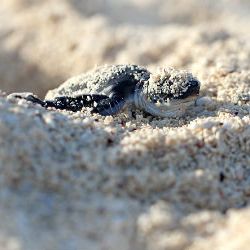Leatherback Turtles Take Advantage of Lockdown

The widespread instruction to stay at home amidst the coronavirus pandemic, and subsequent drop in the number of tourists, has provided wildlife, in many parts of the world, with a chance to thrive.
Increase in Leatherback Turtle Nests
One such example can be found in Thailand where the largest number of nests of Leatherback Turtles have been reported in 20 years due to the empty beaches.
According to the Phuket Marine Biological Centre, 11 turtle nests have been found since November which is the highest number in 2 decades.
Declining number of nests over recent years is largely down to an increase in people using the beaches resulting in the destruction or disturbance of the turtles natural nesting habitats. Both tourism and the fishing industry is largely accountable for the increase in human activity.
The increase in nests shows that turtles are taking advantage of humans being absent from their habitat. Leatherbacks typically like to lay their eggs in dark and quiet areas, away from human activity.
Leatherback Turtles endangered
Leatherbacks are the worlds largest sea turtles, growing up to 60 inches long. They get their names from their leather like shell, which is different to other turtles shells which are hard. Leatherbacks are one of the most migratory turtles, crossing both Atlantic and Pacific oceans. However, despite wide distribution, their numbers have declined over the past 50 years.
Their status, according to the International Union for Conservation of Nature (IUCN) is vulnerable, but some subpopulations such as those nesting on the beaches in Thailand are considered endangered.
If you are interested in learning more about how to help protect turtles please visit our Adopt a Turtle page.



